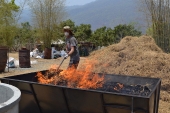
 1
1




 2
2




 1
1




Casie Becker wrote:Everything I hear about gardening in Florida suggests to me that one of your biggest hurdles to most gardeners is the sand. Your neighbors raised beds could very possible have more in common with very large pots that in ground gardens. You would probably find this thread https://permies.com/t/51454/building-soil-sand useful.
What things have you actually already figured out? Are you still figuring out your local resources, plans for irrigating, planting lists, ect? How much time do you have to devote to this project, both for maintaining it and how long you'll have the property? Many of our answers and suggestions need to be tailored to the circumstances, so more detail can help get more useful responses.
You can absolutely have a food forest. In fact, looking at that climate data and adding it to what I know about Florida's conditions, you're starting out in much better shape than many of the success stories on this site.
 3
3




Idle dreamer
 3
3




 And take notes. Beating one's self up because one doesn't have the answer immediately, having just learned about permaculture and just purchased a property, is a misuse of the land's human resource.
And take notes. Beating one's self up because one doesn't have the answer immediately, having just learned about permaculture and just purchased a property, is a misuse of the land's human resource.  Be kind to yourself! Take this time to get to know your property, and what the natural, wild state of it used to be and ultimately wants to be: forest, savannah, ...? Understand that you may be a pioneer in permaculture in your area. Consider that exciting!
Be kind to yourself! Take this time to get to know your property, and what the natural, wild state of it used to be and ultimately wants to be: forest, savannah, ...? Understand that you may be a pioneer in permaculture in your area. Consider that exciting!
 1
1




 3
3




 5
5




1. my projects




Living in Anjou , France,
For the many not for the few
http://www.permies.com/t/80/31583/projects/Permie-Pennies-France#330873
 2
2




 1
1




Regan Dixon wrote:And, please forgive my ignorance about different Florida biomes, but David Goodman (David the Good) did permaculture at his place in Florida. He's made instructional videos which you could google, or maybe find here. His techniques may be applicable to your place. You will be able to judge that, better than I can.




 2
2




Yes, I'm that David The Good. My books are here: http://amzn.to/2kYcCKp. My daily site is here http://www.thesurvivalgardener.com and my awesome videos are here https://www.youtube.com/subscription_center?add_user=davidthegood
 1
1




 1
1




Yes, I'm that David The Good. My books are here: http://amzn.to/2kYcCKp. My daily site is here http://www.thesurvivalgardener.com and my awesome videos are here https://www.youtube.com/subscription_center?add_user=davidthegood
 2
2




David The Good wrote:JJ - drop me a message. I'll send you a copy of my Create Your Own Florida Food Forest booklet. There are species lists in there that will help.
Basically, the biggest thing in Florida is to get a lot of plant mass growing fast. The soil isn't fertile and a lot of the good stuff is in the plants and trees themselves. I built a great food forest over time. Plant lots of nitrogen fixers and Tithonia diversifolia for chop and drop - it will help immensely. Trying to get fruit trees established in the sand is a pain without that support.
I'll help you - it's a great place to grow a food forest.




Yes, I'm that David The Good. My books are here: http://amzn.to/2kYcCKp. My daily site is here http://www.thesurvivalgardener.com and my awesome videos are here https://www.youtube.com/subscription_center?add_user=davidthegood








David Good wrote:Very good - Mart is a great guy.
Peach trees will start from seed and can bear in 2-3 years in Florida, so that's one option. There are some good permaculture Meetup.com groups in the state with people trading scion wood, cuttings, seeds, etc. And since you know Mart, ask him about cuttings. He knows almost everyone.
Mosswood Farm Store in Micanopy has a lot of my old plant varieties, too.




 2
2





Dave's SKIP BB's / Welcome to Permies! / Permaculture Resources / Dave's Boot Adventures & Longview Projects















|
Looky! I'm being abducted by space aliens! Me and this tiny ad!
rocket mass heater risers: materials and design eBook
https://permies.com/w/risers-ebook
|






